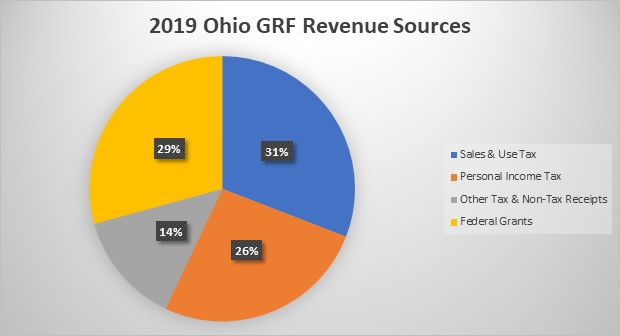Ohio might pass a two-year operating budget by June 30, 2021, but the real work is beginning now inside Governor DeWine’s administration. The Governor’s Office of Budget and Management (OBM) recently released the Fiscal Year 2022-2023 budget guidance documents, which go to each of the state’s cabinet agencies and other departments and non-cabinet agencies. Every two years the State of Ohio passes a bi-annual operating budget to fund the state agencies as well as K-12 schools, Higher Education, Medicaid and the list goes on.
Preparation for the new operating budget will be impacted by the revenue and spending provisions of the last budget- Ohio House Bill 166. HB 166 provides state and federal General Revenue Fund appropriations totaling $33.90 billion for FY 2020 and $35.89 billion for FY 2021, increases of 4.3% and 5.9%, respectively. Medicaid and K-12 Education account for 47.2% and 28.1%, respectively, of the biennial total. State-source GRF appropriations total $23.94 billion in FY 2020 and $24.74 billion in FY 2021, increases of 4.7% and 3.3%, respectively. K-12 Education and Medicaid represent 40.2% and 24.3%, respectively, of the biennial total. Across all funds, main operating budget appropriations total $70.28 billion in FY 2020, an increase of 5.2%, and $72.99 billion in FY 2021, an increase of 3.8%.

House Bill 166 continued the state’s reliance on the sales tax for the majority of its General Revenue Funding followed closely by its collection of personal income tax.
In late July OBM released the new guidance to help prepare for next year’s budget submission to the Ohio General Assembly. The budget submission is expected to be issued by February 1, 2021 which will begin the race to June 30, 2021 Ohio’s required date for the budget to be passed and signed into law.
Some important key dates are coming up based on the OBM guidance. Beginning this month on September 15th non-cabinet agencies and on October 14th respectively are the dates OBM has asked these entities to submit their budget request and priorities to OBM and the Governor’s office for further review.
Like past years the OBM guidance has asked each entity to submit their budget request based on a level of 10% less than what they were appropriated at in the FY 2020-2021 budget. This is especially important during this process due to the lingering effects of the COVID-19 outbreak and the resulting economic fallout that has occurred in Ohio. The DeWine administration has projected the FY 21’ budget deficit at $2.5 billion, which is likely to effect Ohio’s fiscal position heading into the next budget debate. What is certain is that Ohio isn’t likely to have the same level of funding that was previously appropriated in the current bi-annual budget.
With the knowledge that this budget is likely to be more challenging than the current operating budget, now is the time to develop a lobbying strategy for the next budget. Key strategies could focus on
- Promoting the retention of existing policy and budget items with state agencies;
- Promoting the adoption of new policy and budget items for new programs with state agencies; and
- Briefing key legislators on ideas for project or program earmarks in the administration’s’ budget in preparation for the budget discussions between the Ohio General Assembly and Governor Mike DeWine.
Please contact Dave Robinson at [email protected] or Tim Biggam at [email protected] if you need assistance with any Statehouse lobbying.